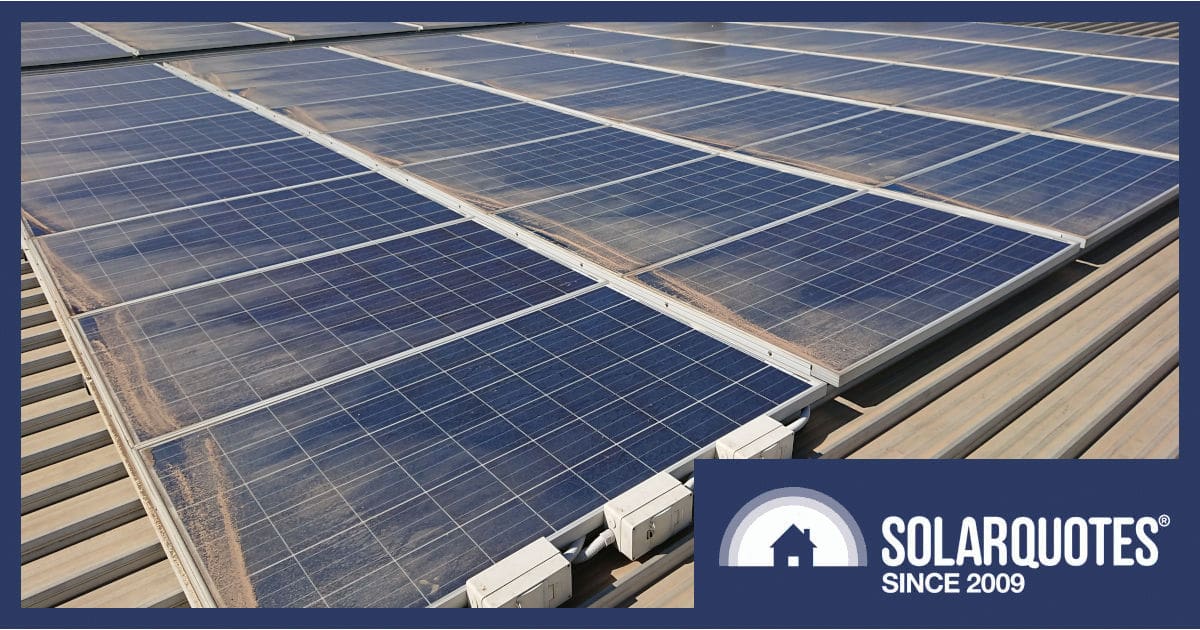
You may have heard that flat solar panels require regular cleaning, but those angled at 10° or more don’t. But is it really true?
In a nutshell, yes. Solar panels angled above horizontal wherever possible can give give better returns with less maintenance. Here’s why.
Flat Solar Panels Get Flat-Out Dirty
Some years ago I was sent to diagnose a poorly performing system on a local council office. It was a modern building with a low-pitch deck roof of perhaps 1° or 2°. The solar was parallel to the roof, and essentially flat.
Checking the array voltage and short-circuit current proved there was DC available, however overcast conditions meant it was impossible to properly test how well the solar panels were working.
The tech support people could see it was online, but this particular model should never throw the particular fault codes we were seeing. We agreed it was toast and processed a warranty claim.
Cue my surprise when co-worker Mitch hung the new inverter, and it still didn’t work.
When Mitch clambered onto the roof he found a heavy layer of dirt built up on the array, concentrated on the lower edges of the panels.
After a good deal of hose and broom work the system performance was restored, but it was a vivid demonstration of what a dust storm in a country town could do.
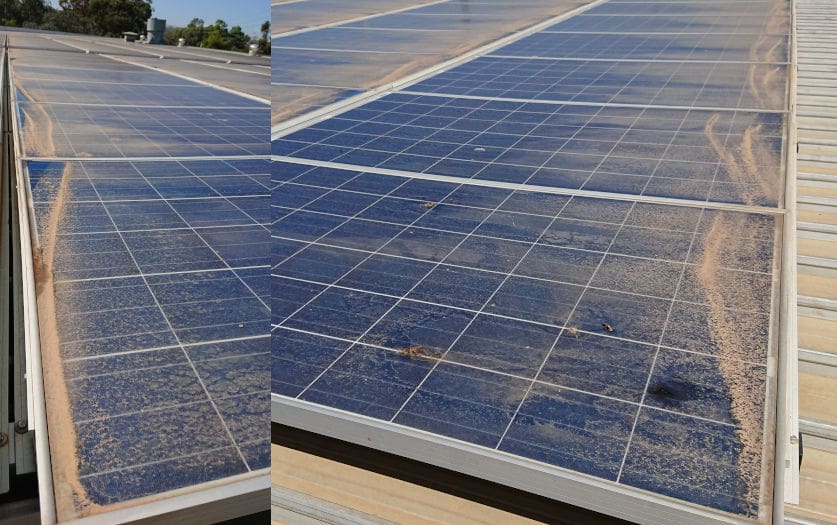
These flat solar panels are flat-out filthy.
Self-Cleaning Solar Will Always Work Better
It makes perfect sense that every shower of rain should rinse your panels clean, not concentrate dirt on them. Even the most disciplined and fastidious hose owner isn’t going to specifically clean their panels every week.
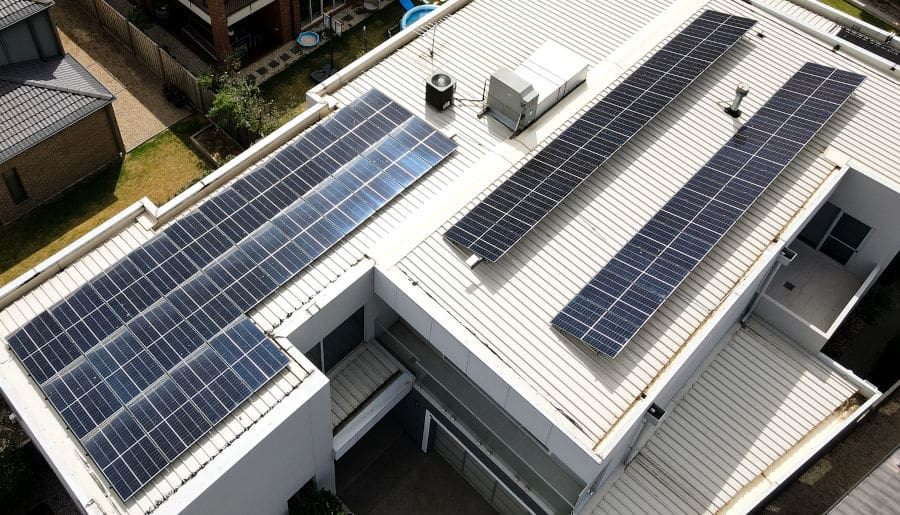
Here we have streaks of dirt across low-pitch panels on the left, while clean panels on the right are pitched up and cast shadows. If these panels were angled back-to-back there would be room for a whole extra row.
This is why the CEC guidelines for solar installation call for at least 10° pitch on solar arrays.
If your array doesn’t have this slope, then your handover pack (which details everything you need to know about the system) must have a specific warning: the yield you were promised in your initial quote will only be maintained with regular extra cleaning.
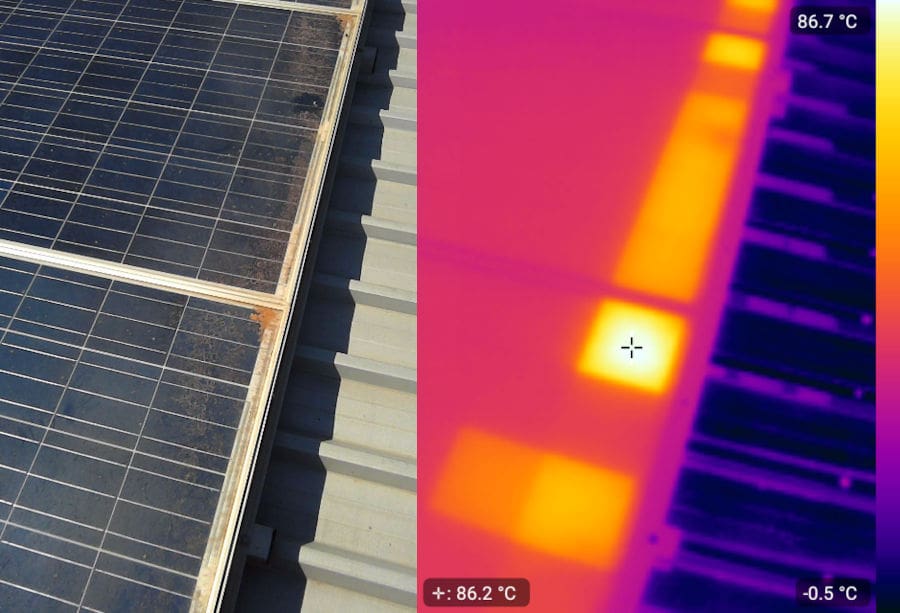
It doesn’t look very dirty but this is the most vivid way to explain that shaded cells get excessively hot
Breaking The Surface Tension Helps
Believe it or not, I’ve found gum leaves help keep an array clean. Sitting in just the right place across the edge of the frame, a simple leaf breaks the surface tension of pooled water, creating a drain path over the edge.
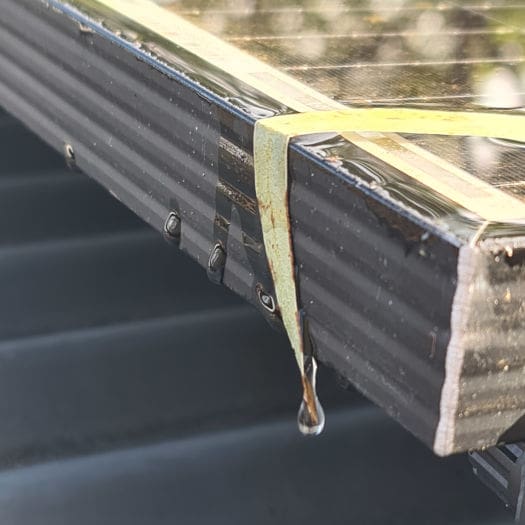
Finding one dry panel in a row of five prompted me to install a gum leaf. Hey presto, panel drained.
Solarud’s drain clips operate on this same principle. While I haven’t used them personally, their easy installation and potential to reduce cleaning frequency means they can’t hurt.
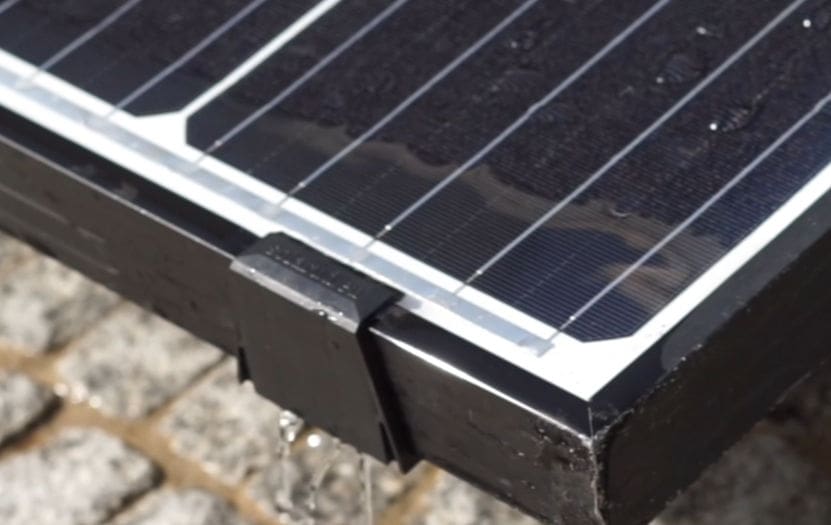
You can see the meniscus of water draining away from this panel, dripping from the bottom of the Solarud clip.
What About Frameless Solar Panels?
While frameless panels are available, they’re fussy to install, easily damaged and require a maintenance schedule to check the torque of the clamping bolts every year or so. That’s why almost all solar panels have an aluminium lip around the edge. When they’re laid flat (or close to), the dust that inevitably builds up gets washed to the lowest edge, but not washed off.
Some manufacturers include drain grooves in module frames to prevent water pooling, which I think should be an industry standard, but sadly isn’t common.
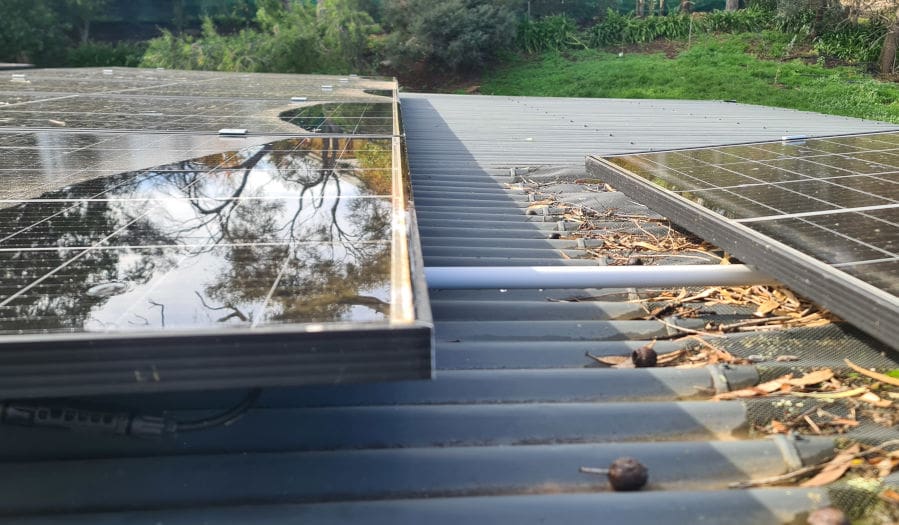
These panels fall towards each other, but the array on the left has slightly more pitch so stays cleaner.
Angled Panels Have Other Advantages
Cooler Running
Lifting panels off the roof means they’ll run cooler, and produce more energy than flat solar panels because of it.
Easier Maintenance
It also means array wiring is more easily installed, and plugs can be clipped out of the weather. The height is also a boon for electricians trying to diagnose possible earth faults, plus this increased serviceability will negate one of the disadvantages of microinverter or optimiser systems: having to remove panels to access failed hardware.
Easier Cleaning
If you’ve ever had to remove a pigeons’ nest or a buildup of flammable leaf litter, you’ll appreciate that accessing the space under the panels can be incredibly difficult — to the point that removing the whole array becomes the only option.
That means extra traffic on the roof; seized and broken hardware; and potential electrical issues from disturbed wiring and unsealed plugs. Being able to clean without opening that can of worms is another huge advantage.
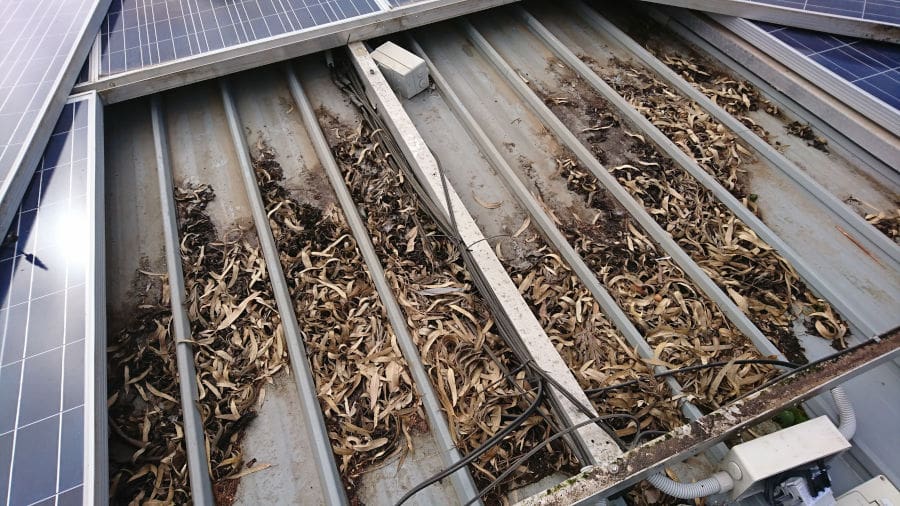
This old array was a bit of a fire hazard, besides the bad cabling.
While the wind can help keep a roof clean, some pitched frames cause a buildup of leaves.
Believe it or not, I’ve had real difficulty removing leaf litter because my garden blower isn’t strong enough to break apart leaves clumped by spider webs. So being able to get under the array is priceless.
Crinkle Cut Solar Should Be The Standard
With flat solar panels, there’s a risk people will treat it like any other part of the roof and just traipse across the array, causing untold and invisible damage by smashing the wafers under the glass.
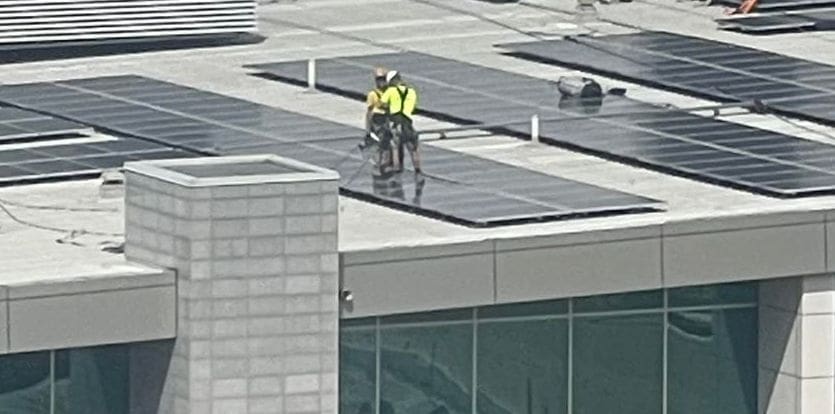
Either they don’t know or don’t care, but these two construction workers have just wrecked whatever part of the array they’ve walked on.
Angled arrays placed back-to-back can make it easier to create any necessary access paths.
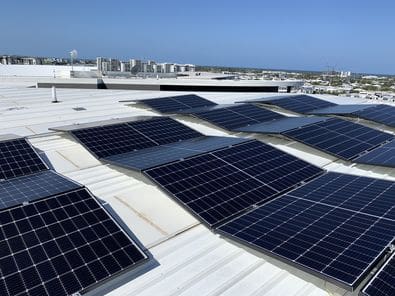
Not only are these arrays from Positronic Solar in Brisbane self-cleaning, they have access for servicing.
Best of all, you can avoid long shadows that limit panel coverage and solar yield on a given roof. It’s more wattage for winners.
East-West tilted panels are recommended on a flat roof, for more energy at the beginning and end of the day. But even it you have to tilt North-South, the 10° angle won’t damage the yield as much as a thick layer of dirt.
Angled Panels Last Longer
If you still need convincing to avoid flat solar panels, please be aware that tilting solar panels also prevents water pooling, meaning you don’t risk the panel warranty.
Perhaps most importantly, you avoid the annoying reliability problems that come from moisture ingress and show-stopping earth faults.
So, please, if you have a flat roof, tilt your solar panels at least 10º, ideally in an east-west, back-to-back arrangement. Your panels and your electricity bill will thank you even if your local solar panel cleaning company won’t.
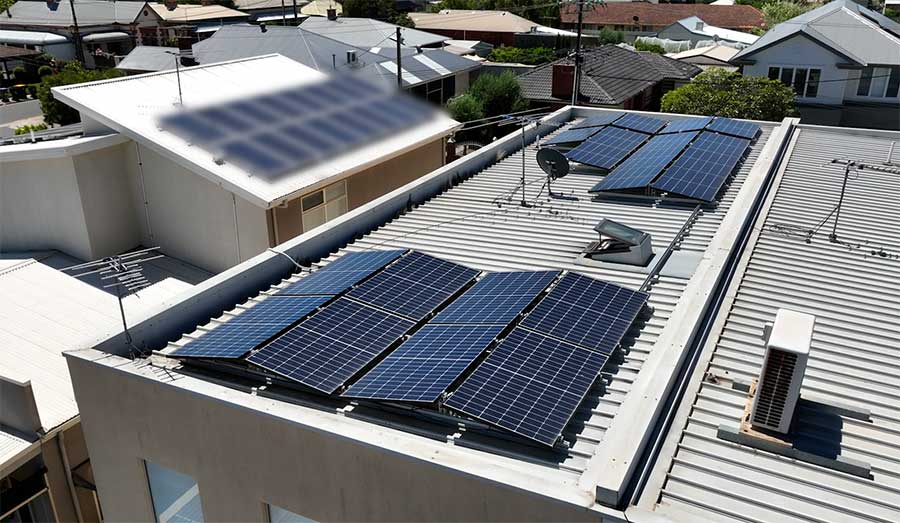
Sparkling clean, East-West tilted solar panels on a tricky flat roof.

 RSS - Posts
RSS - Posts



Can you really stand on Solar Panels? This just gave me the great idea of a new job! Your guy just wrote up a warranty claim, doing a few multimeter tests on the ground? He didn’t go up to check the panels?
This is where the new drone technology comes in! Just imagine a drone that can spray a cleaning solution. Getting up on roofs isn’t ever easy. I even bought a cheap drone, just to look at my panels.
Hi Eric,
Standing on solar modules is a great way to ruin them. https://www.youtube.com/watch?v=gGwUdV8zjUk&t=31s
Very reputable solar companies actually use drones with thermal cameras to identify the damage from foot traffic or hail
Not long ago, I reinsured the house and contents, but the person could not show me if our solar system was insured and if so, for what.
Hail damage is the most obvious, but what about the neighbour’s trampoline or roofing?
What about surge or fusion issues? Should the solar system be insured separately?
Great question Eric,
On my own place the solar is mentioned but isn’t detailed. The PDS document has solar in the fine print but yours might vary of course. Probably can’t hurt to have it documented with them, like you do accessories on a car insurance policy. I have also seen inverters claimed under fusion damage, however if you want to make a claim I suggest you mention “storm damage” and nothing else. Using other words like surge, spike or lightning might give them cause to exclude a claim under a technicality.
Hi Eric,
I had batteries installed before christmas. The installer suggested letting the insurer know. Gave them a call, and they advised while it wasn’t required to let them know, they appreciated the info update and noted it on the policy. They covered it as part of the building structure. So you’re not under insured, add the cost to next years building value.
We are doing a project near Dugong, NSW. The homeowner’s insurer is only going to cover the solar panels ‘like for like’, so the homeowners needs 6 x panels of 300watts. Good Luck. Or a new system that requires a new inverter, The insurer is not paying for an inverter, new racking equipment, new cables as they were not damaged. Just; ‘like for like’ 7yr old panels.
My neighbour just built a house adjacent to his existing home. This is the first time I’ve seen panel supports on the downward slope of the roof except for my own which I built 17 years ago. Their panels are still only 30 to 40mm off the roof whereas I raised mine about 120mm to provide cooling and ease of cleaning the roof. It seems that the aesthetics of the arreys are more important than the long term efficiency. Putting the supports horizontal makes it hard to remove leaves etc and can lead to corrosion if metal roof due rotting leaves forming an acid.
My roofs are 40 deg (N & W) & 14 deg (S), the former to maximise winter production, while incidentally improving convection cooling. It is encouraging to read that the latter may be enough to allow only infrequent manual cleaning.
The installer has agreed to fit birdproofing to the flatter array, but so far I’m guessing that 40 deg is a bit steep for nesting, especially as the racking will be uphill, on top of the decking ridges, for minimal impediment to nest fall-through. (If necessary, aided by the firepump & firefighting nozzle. That can probably do a good bit of cleaning too, if not overdone. It is already great for sluicing the spouting once a year. Two jobs at once might be the program in future.)
You’d hope so but unfortunately not.
Each racking rail has an attachment through to either the underlying roof timber or to the standing seam metal roof.
This attachment provides a point for birds (such as persistent pidgeons) to start building a nest.
For the first 8 years we never had a problem. For some reason though a large flock of pidgeons have moved into our suburb over the last 5 years (before Covid cut off their CBD food supplies).
Two pairs adopted our roof & panels and it has been war since then.
Carefully dismantling their nests under the panels as soon as more than 3 or 4 twigs (except when away unfortunately & two eggs hatched…).
Getting up on the roof late in the day to scare them off, putting a 20 tune doorbell under the panels (worked for 8 days…).
The nest dismantling, strong winds (seeing some eggs tumble off the roof), and ;visits has discouraged one pair but the second pair continue the battle.
The latest – a solar powered Kookaburra that lights up at night. Worked for 3 weeks only, scaring the pidgeons that is, even though incredibly realistic. Doorbell shortly to be removed.
Our panels are at 10 degrees (measured).
The problem here in Perth is that it doesn’t rain for maybe 3-4 months over summer. Other times it may only sprinkle – which causes dust to set as dried mud.
Following Finn’s article, I cleaned the panels – hadn’t done this for about 2 years, following earlier advice.
The rinsing water came off as mud, and quite some effort was required to get the glass reasonably clean.
So, I don’t think 10 degrees is steep enough for effective cleaning (although obviously better than 0 degrees) – nor do I believe panels will self-clean effectively in places like Perth, regardless.
Having said all that, the improvement in performance following cleaning was relatively small – although I did see our inverter clip at 5kW for much longer around midday.
Interestingly, I saw several websites extolling the urgent safety requirement to turn the inverter off during cleaning panels – in case panel plugs have water ingress. Don’t these people understand that switching the inverter off will only cause strings to INCREASE their voltage (to open circuit levels)?
A safer option is to clean the panels early morning or late evening (better for limiting thermal shock as well) – as I did – panels are always ‘live’ when the sun is shining – regardess of the inverter switch position.
I should think panel frames would be grounded, and inverters should have earth leakage shutdown anyway.
Thanks Ian,
All very good points.
I have a 7 degree roof in Brisbane (Pretty much perfectly north facing). I was intending to install 22 panels in landscape.
Is it still advisable to do east west tilt to improve self cleaning? Seems a bit excessive. Maybe just invest in the clips?
It does rain quite heavily here. And I doubt mud build up will be a major issue. But I can see the issue of water pooling.
Hi AL,
You’ll probably get away with 7 degrees.
Due east & west is great for increasing yield before 9am & after 3pm… when the power can be triple the value.
If you plug your array figures into PVWatts it might give you an idea on total yield but I don’t have a go to link for modelling the shape of a daily yield curve to electricity price sorry.
Will work on that.
Cheers
That’s my northern array I am planning.
I got another 9 panels in east west orientation on another roof at 22.5degrees.
I’m down the south of Vic, we have a flat roof, my panels are on frames at about 25° because the wind being strong, probably didn’t need to, at this angle the birds walk all over them and poo everywhere, so maybe I should have made them more like 48° to make it harder for the birds and the ideal angle for down here.
We have been coerced unfortunately by a dodgy operator (amazing solar, absolute hell to deal with, and not cheaper option either, just pushiest I guess), to install our 15 panels effectively flat on our 3 degree pitched roof. Surely because cheaper for them, but I’m sure our contact/quote initially indicated less than 30 but greater than 0. They’ve only gone up last month, but due to height of our roof we can’t hose them down or clean them. What would be simplest option to get someone to come and put in tilt frames or have this corrected?
‘Crinkle cut’ panels sounds like a great idea and solution.
I’ve never been offered anything like this for our flat roof panel install during the quoting phase (currently underway). How much extra work is it for an installer and is it something we could request on the day?
Well speaking as an industry veteran,
Technically any solar that isn’t parallel and within 100mm of the roof needs to have council planning permission which cites the racking manufacturer specifications and probably engineering on the building they’re being screwed to. I’m sure that in many cases this never happens, but things have changed a little with recent updates to AS1170(?) for wind actions on buildings.
I would mention it to the installer when you get them to quote as there will be extra parts and labour involved for a full 10° pitch.
I have seen some cheats done for extra tilt using tile extension brackets or spacers under legs, but that would only work with a pragmatic installer.
I’ve previously read some of the threads here on panel cleaning, and quite a large dispersion of claimed results of cleaning had me thinking about easier verification. It occurred to me that I already had the tools to decide for myself without laboriously cleaning every panel.
Our system brand is SolarEdge, with power optimizers on every panel so the array performance is not hobbled by one dirty or shadowed panel. The upshot of the SE optimizers is that every panel records it’s own daily output, and weekly, monthly etc in the SolarEdge Monitor software online. My panels have never been cleaned since installation 2.5 years ago (in Adelaide SA).
So I found two panels on one array that have had near exactly the same output per day, week, month. Then I cleaned just ONE of those two on the array and then started recording the daily difference in % after that.
The resulting difference has been very consistent for a week so I think the result may be valid. I’m going to find another matched pair and clean just one again to be sure. The result of doing this is I’ll know what gains I can get, accurately, without bothering to clean all the arrays.
If anyone else has a SolarEdge system maybe verify my single panel testing method, I’d like to hear how it went with different angled panels, mine are all at 25 degrees…
Follow up from my previous post above.
I’ve repeated my own ‘cleaning benefits self-test’ using the SolarEdge individual panel generated data, and got a result within a fraction of the first one (on a 25 deg tilted array).
First matched pair of panels, the cleaned panel improved by 1.4% per day.
Second matched pair, again just one of the two cleaned, got an improvement of 1.5% per day.
It would be interesting to see results from shallower angled arrays and chart the differences…